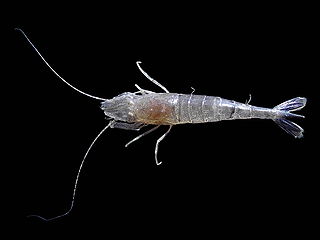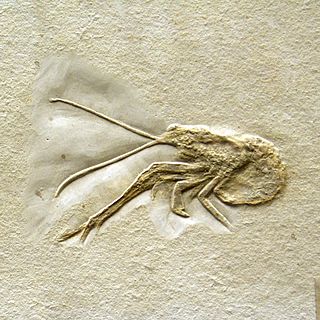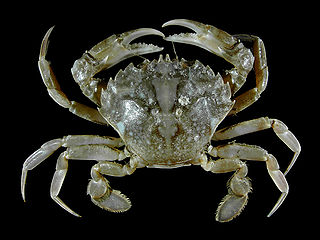
Aeger is a genus of fossil prawns. They first occur in the Early Triassic, and died out at the end of the Late Cretaceous. A total of 21 species are known.

Crangonidae is a family of shrimp, of the superfamily Crangonoidea, including the commercially important species Crangon crangon. Its type genus is Crangon. Crangonid shrimps' first pair of pereiopods have partially chelate claws that they use to capture their prey. They burrow shallowly into sediment on the sea floor, and feed on bivalves, crustaceans, polychaetes, and some small fish.

The Majoidea are a superfamily of crabs which includes the various spider crabs.

Mecochirus longimanatus is an extinct species of lobster-like decapod crustacean from the Jurassic of Europe.

Carpilioidea is a superfamily of crabs containing a single extant family, Carpiliidae and three extinct families. The modern range of the family includes the Indo-Pacific, Western Atlantic and Caribbean Sea. The fossil record of the group extends back at least as far as the Paleocene.

Albuneidae is a little-known family of specialized burrowing sand crabs. There are 50 extant species as well as nine fossil species that have been described. Fossil specimens have been described from the Cretaceous, Miocene and Oligocene.

Eubrachyura is a group of decapod crustaceans comprising the more derived crabs. It is divided into two subsections, based on the position of the genital openings in the two sexes. In the Heterotremata, the openings are on the legs in the males, but on the sternum in females, while in the Thoracotremata, the openings are on the sternum in both sexes. This contrasts with the situation in other decapods, in which the genital openings are always on the legs. Heterotremata is the larger of the two groups, containing the species-rich superfamilies Xanthoidea and Pilumnoidea and all the freshwater crabs. The eubrachyura is well known for actively and constantly building its own burrows. The fossil record of the Eubrachyura extends back to the Cretaceous; the supposed Bathonian representative of the group, Hebertides jurassica, ultimately turned out to be Cenozoic in age.

Erymidae is a family of decapod crustaceans known only from fossils. They survived for 100 million years, from the Permo-Triassic boundary to the Albian. Eleven genera are recognised:

Cheiragonidae is a small family of crabs, sometimes called helmet crabs, placed in its own superfamily, Cheriagonoidea. It comprises three extant species, Erimacrus isenbeckii, Telmessus acutidens and Telmessus cheiragonus, there are no yet evidences of Cheiragonidae in the fossil record. Many of these crabs were formerly treated as members of the Atelecyclidae.

Goneplacoidea is a superfamily of crabs containing 11 extant families, and two families known only from fossils.

Acanthochirana is an extinct genus of prawn that existed during the upper Jurassic period. It was named by E. Strand in 1928, and its type species is Acanthochirana cordata. They are distinguished from the related genus Aeger by the presence of teeth on the rostrum, which are absent in Aeger.

Branchioplax is an extinct genus of crab which existed in Alaska and Washington during the Eocene period. It was first named by Mary Rathbun in 1916, and contains ten species, including Branchioplax washingtoniana from the Hoko River Formation, Branchioplax carmanahensis, and Branchioplax ballingi.

Longichela orobica is an extinct species of prawn which lived in the Norian, and is the only species in the genus Longichela.
Hepatella is a genus of crabs in the family Aethridae, containing these species:

Hepatus is a genus of crabs in the family Aethridae, containing seven extant species, plus some fossil species:

Atergatis is a genus of crabs in the family Xanthidae, containing the following species:

Campylonotoidea is a superfamily of shrimp, containing the two families Campylonotidae and Bathypalaemonellidae. Fenner A. Chace considered it to be the sister group to the much larger superfamily Palaemonoidea, with which it shares the absence of endopods on the pereiopods, and the fact that the first pereiopod is thinner than the second. Using molecular phylogenetics, Bracken et al. proposed that Campylonotoidea may be closer to Atyoidea. There are sixteen described species in 3 genera; no fossils are known.

Eryma is a genus of fossil lobster-like crustaceans, containing 44 species.

Coeloma is an extinct genus of crabs belonging to the family Mathildellidae. The genus includes 19 species, distributed among several subgenera, and is in need of revision. The fossil record of the genus extends from the Eocene to the Miocene.

Dynomenidae is a family of crabs in the superfamily Dromioidea mostly found in Madagascar. There are nineteen genera in this family: five extant and fourteen known from fossils:


















